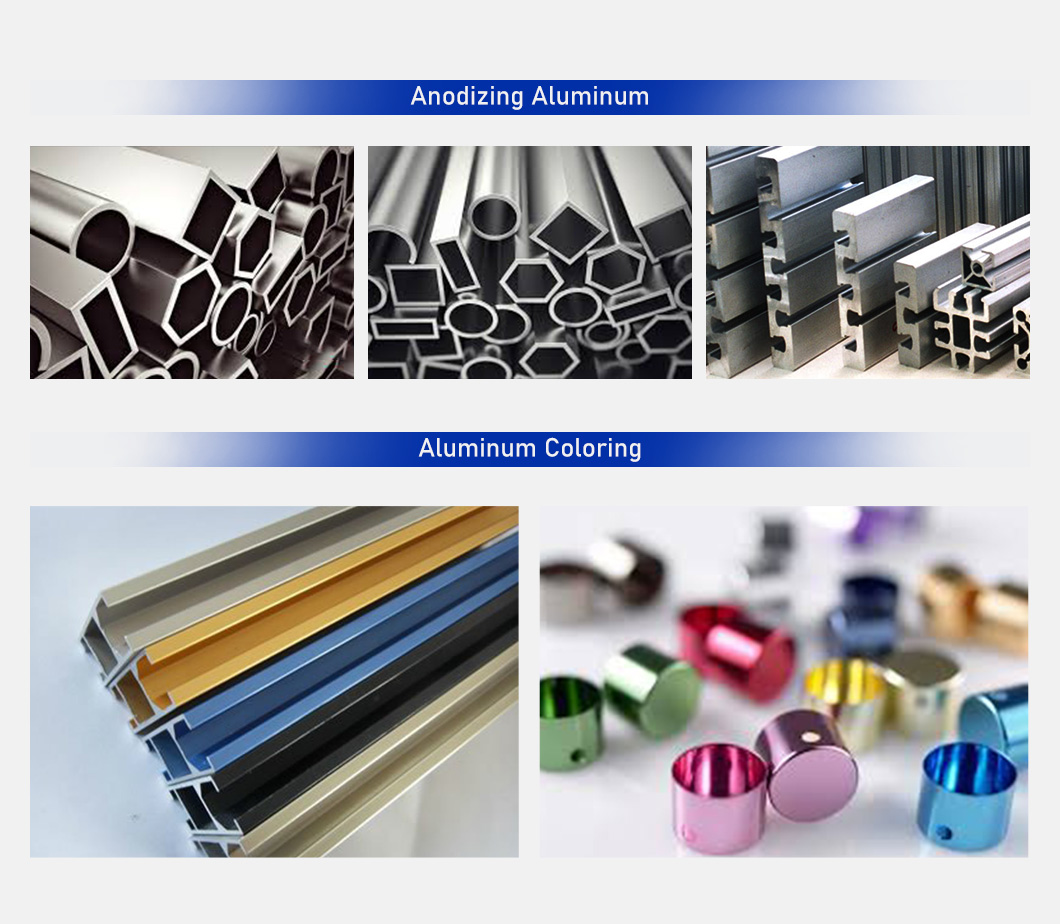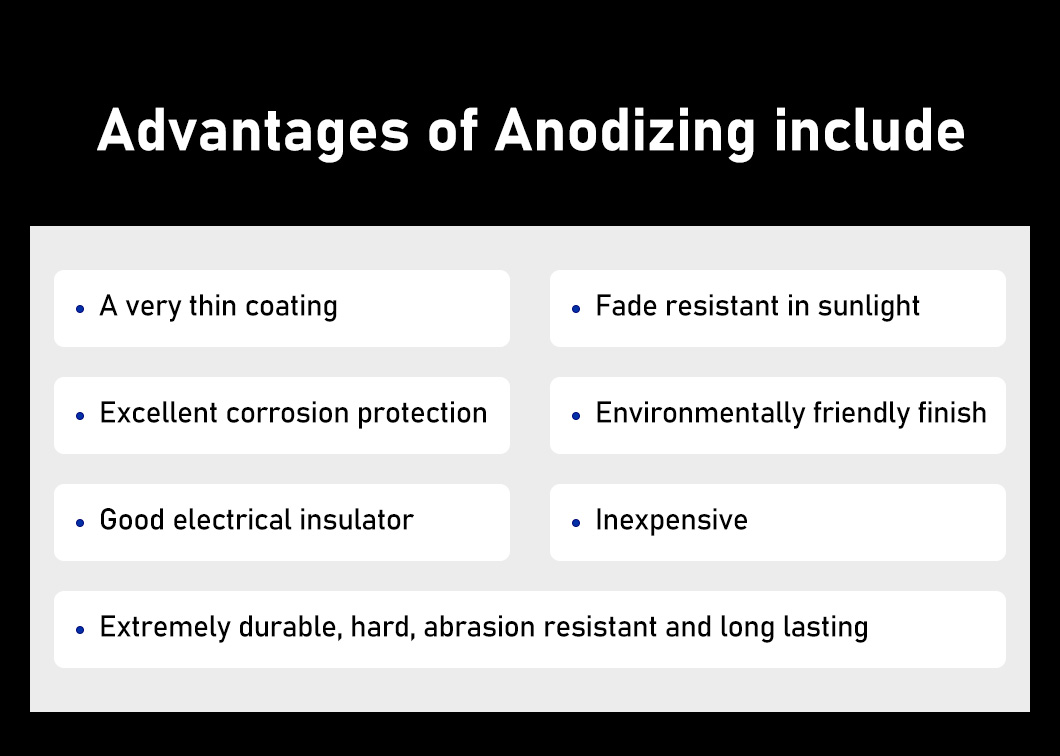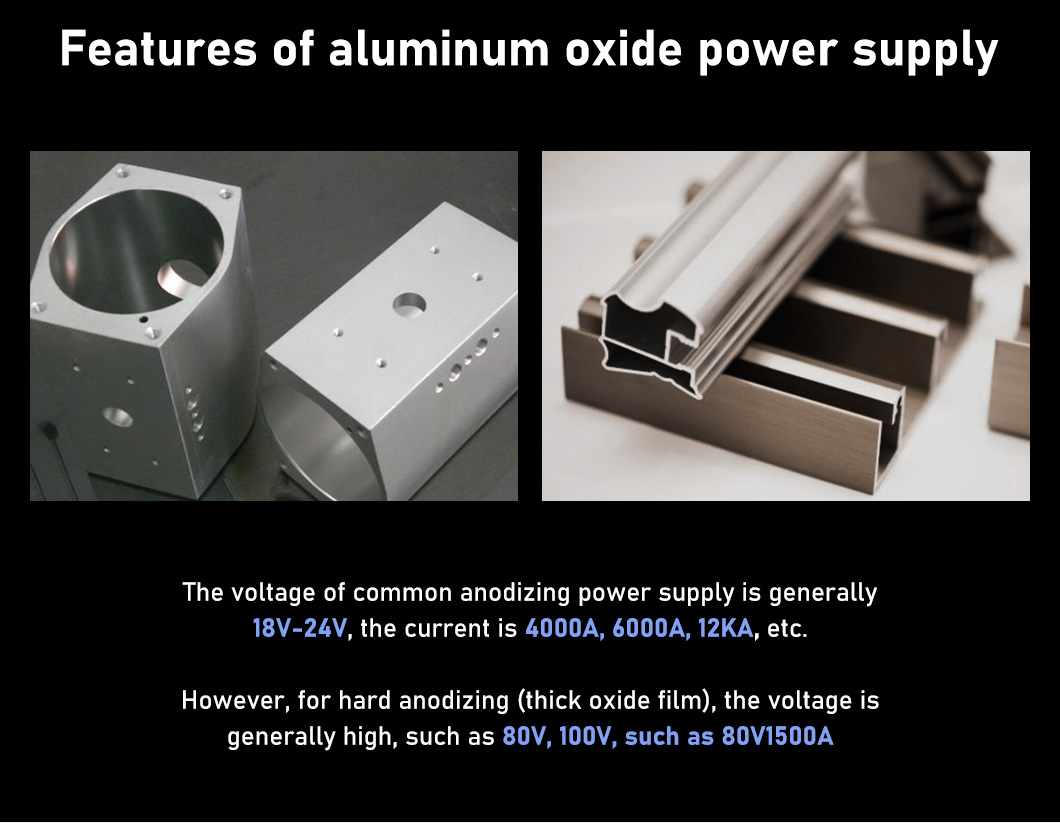Input parameters: Three phase, AC380V±10% ,50~60HZ
Output parameters: AC : 0~30V 0~20KA DC : 0~30V 0~20KA
Output mode: AC/ DC output
Cooling method: Water cooling
Power supply type: Silicon Controlled Rectifier
Application Industry: Oxidation of aluminium profile and AC/DC coloring
Anodic oxidation includes both aluminum anodizing and hard anodizing. Anodic oxidation (anodic oxidation), electrochemical oxidation of metals or alloys. The process of forming a layer of oxide film on aluminum products (anodes) under the action of an applied current in aluminum and its alloys under the corresponding electrolyte and specific process conditions. The so-called anodic oxidation of aluminum is an electrolytic oxidation process in which the surface of aluminum and aluminum alloys is usually transformed into a layer of oxide film, which has protective, decorative and some other functional properties.

Ordinary decorative anodizing requires a DC power supply voltage of usually 20V-24V, while hard anodizing usually has a higher voltage depending on the process, sometimes reaching 80V, 100V, 120V, etc. The current is determined by the size of the workpiece to be anodized, ranging from a few hundred amps to tens of thousands of amps.

Aluminum oxidation coloring, using artificial methods to make aluminum and its alloy products surface to generate a layer of oxide film (Al2O3) and apply different colors, in order to improve the wear resistance of aluminum, prolong the service life and increase the color and beauty. The basic process of oxidation coloring is aluminum surface treatment, oxidation, coloring and subsequent hydration sealing, organic coating and other treatment processes. The coloring methods of oxide film are chemical coloring, electrolytic coloring and natural coloring, etc.


Characteristic Types |
Parameter Items |
Technical Requirements |
| Power Types | Power types | Silicon Controlled Rectifier |
| Model and specifications | AC/DC-20KA/30V | |
| Cooling mode | Water-cooled | |
| Switch tube type | SCR Thyristor | |
| Input Characteristics | Rated Input Voltage | Three-phase, AC380V±10% ,50~60HZ |
| Rated Input Power | 287KW | |
| Rated Input Current | A phase, C phase AC 928A, B phase 5A | |
| Input Power Factor | COSΦ≥0.85 | |
| Output Characteristics | Output Voltage | DC:0~30V AC:0~30V |
| Output Current | DC:0~20KA AC:0~20KA | |
| According to accuracy | 1A,0.1V | |
| Rated Output efficiency | ≥85% | |
| Environmental Conditions | Installation site | Indoor installations |
| Altitude | ≤1500 meters | |
| Ambient temperature | -20℃~45℃ | |
| Relative humidity | ≤90% | |
| Control Mode | Operating mode | PLC, ADDA, Ethernet, RS485 and RS232 |
| External Dimension | Height*Width*Depth | H2300mm×W1500mm×D2300mm |
| Protection Characteristics | With over voltage, over current, overload, short circuit, overheating and other abnormal self-protection function | |
| Application | Model | Output Parameters |
| Aluminum anodizing | TBSB-2500A25V | 25Vdc/2500A |
| TBSB-100A30V | 30Vdc/100A | |
| TBSB-1000A25V | 25Vdc/1000A | |
| TBSB-750A25V | 25Vdc/750A | |
| TBSB-700A40V | 40Vdc/700A | |
| TBSB-500A40V | 40Vdc/500A | |
| TBSB-300A50V | 50Vdc/300A | |
| TBSB-200A24V | 24Vdc/200A | |
| TBSB-100A40V | 40Vdc/100A | |
| TBSB-100A24V | 24Vdc/100A | |
| TBSB-50A20V | 20Vdc/50A | |
| TBSB-16KA22V | 22Vdc/16KA | |
| TBSB-14KA22V | 22Vdc/14KA | |
| TBSB-12KA22V | 22Vdc/12KA | |
| TBSB-16KA22V | 22Vdc/16KA | |
| TBSB-12KA22V | 22Vdc/12KA | |
| TBSB-1000A15V | 15Vdc/1000A | |
| TBSB-18KA25V | 25Vdc/18KA | |
| TBSB-12KA20V | 20Vdc/12KA | |
| TBSB-20KA150V | 150Vdc/20KA | |
| KGFB-2000A20V | 20Vdc/2000A | |
| KGSB-50KA1000V | 1000Vdc/50KA | |
| TBSB-22KA22V | 22Vdc/22KA | |
| KGFB-1500A/80V | 80Vdc/1500A | |
| TBSB-15KA/22V | 22Vdc/15KA | |
| KGSB-4KA250V | 250Vdc/4KA | |
| TBSB-24KA/22V | 22Vdc/24KA | |
| Colouring | DC/AC-500A/30V | DC/AC-500A/30Vdc |
| DC/AC-12KA25V | DC/AC-12KA25Vdc |
If you need other anodizing rectifier, we can custom design them according to customer requirements. Please contact us.
Seeking 30V 20KA DC/AC industrial colouring rectifier? Liyuan Haina Group, a professional manufacturer with 27+ years specializing in industrial rectifiers, supplies global clients including the United States, Canada, Britain, Italy, Spain, South Africa, Russia, the UAE, Japan, South Korea, Malaysia, etc. Our advanced factory delivers cost-effective Made-in-China solutions, with competitive prices and customizable options. Contact us for sales inquiries.
Hot Tags: 30V 20KA DC/AC Industrial Colouring Rectifier, Anodizing Rectifier, Aluminum oxidation coloring, dc power supply rectifier, Silicon Controlled Rectifier, aluminum anodizing, Manufacturer, Price, Sale, China
Liyuan Haina Rectifier, the professional manufacturer in IGBT and SCR rectifier, committed to providing you with quality solutions and products.
Get more details? We’ll response as soon as possible (within 12 hours).
Liyuan Haina Rectifier, the professional manufacturer in IGBT and SCR rectifier, committed to providing you with quality solutions and products.
Get more details? We’ll response as soon as possible (within 12 hours).